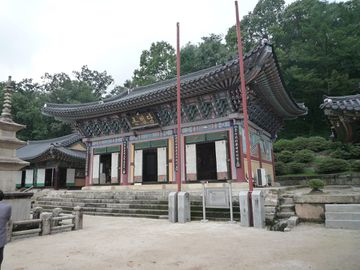남양주 봉선사 큰법당
| 남양주 봉선사 큰법당 Main Buddha Hall of Bongseonsa Temple, Namyangju |
|
 남양주 봉선사 큰법당, 국가문화유산포털, 문화재청. |
|
| 대표명칭 | 남양주 봉선사 큰법당 |
|---|---|
| 영문명칭 | Main Buddha Hall of Bongseonsa Temple, Namyangju |
| 한자 | 南楊州 奉先寺 큰法堂 |
| 주소 | 경기도 남양주시 진접읍 봉선사길 32 |
| 지정(등록) 종목 | 국가등록문화재 제522호 |
| 지정(등록)일 | 2012년 12월 14일 |
| 분류 | 등록문화재/기타/종교시설 |
| 시대 | 기타 |
| 수량/면적 | 1동(현황측량면적 251㎡) |
| 웹사이트 | 남양주 봉선사 큰법당, 국가문화유산포털, 문화재청. " |
|
|
|
해설문
국문
남양주 봉선사 큰법당은 불교 대중화에 앞장선 운허(耘虛) 스님이 1970년 조성한 건물로, ‘대웅전’이라는 명칭 대신 ‘큰법당’이라는 한글 편액(종이, 비단, 널빤지 따위에 그림을 그리거나 글씨를 써서 방 안이나 문 위에 걸어 놓는 액자)이 달려 있다.
‘큰법당’은 한국전쟁 때 다 타 버린 대웅전을 철근콘크리트 구조로 새롭게 지은 것으로 형태는 정면 3칸, 측면 2칸이다. 1960년대 정부의 공업화 정책으로 문화재 건축 사업에도 철근콘크리트 구조를 도입한 시대 상황이 반영된 것이다.
철근콘크리트로 전통 건축물을 모방해 제작하는 것은 당시에 일반적인 방식이 아니었다. 따라서 한식 목구조를 이해할 수 있는 몇 사람의 목수가 공장에서 미리 제작한 콘크리트를 현장에서 조립하는 방식(precast concrete, PC공법)을 사용하여 큰법당을 시공하였다. 큰법당은 전통 건축의 추녀 곡선 등 외형적인 측면에서 기존 전통 목조 기법을 정교하게 묘사하였다고 평가된다.
남양주 봉선사 큰법당은 근대 건축 재료와 구조로 전통성을 표현하고자 했던 1960~1970년대 당시의 기술을 대표하는 사료로서 보존 가치가 있다.
영문
Main Buddha Hall of Bongseonsa Temple, Namyangju
This hall, built in 1970, is the main worship hall of Bongseonsa Temple. It honors Sakyamuni, the historical Buddha who lived in ancient India.
Typically, a Buddhist worship hall honoring Sakyamuni is called Daeungjeon, meaning “Hall of the Great Hero.” However, this hall has the name Keunbeopdang, meaning “Large Dharma Hall,” which was given by the temple’s head monk Unheo (1892-1980). Unheo was a renowned scholar who dedicated his life to translating Buddhist scriptures from Classical Chinese into the vernacular Korean language. He chose the name Keunbeopdang, which implements vernacular Korean, in the hope that it would be better received by ordinary followers unfamiliar with Classical Chinese.
This hall was built using reinforced concrete on the site of the temple’s former main hall, which had burnt down during the Korean War (1950-1953). It is one of the first temple buildings to take advantage of a new government policy implemented in the 1960s that permitted the use of modern construction materials such as cement and steel-reinforcing bars in the construction or renovation of architectural heritage. The building was completed by assembling precast concrete components made under the supervision of a few masters of traditional Korean architecture. While it is made using modern materials, the hall emulates in detail the intricacy of a traditional wooden worship hall, including its eaves and rafters.
영문 해설 내용
1970년에 지은 이 건물은 봉선사의 주불전으로 석가모니불을 모시고 있다.
석가모니불을 모시는 불전은 보통 대웅전이라고 부르는데, 이곳은 봉선사의 주지였던 운허(1892-1980) 스님이 큰법당이라는 한글 이름을 붙였다. 운허는 평생을 경전 국역에 전념하였던 학자이기도 하였으며, 일반 대중에게 보다 친숙한 이름으로 불리기를 바라는 마음에서 이러한 이름을 지었다.
원래 이곳에 있던 봉선사의 주불전은 한국전쟁 때 소실되었고, 지금의 큰법당은 철근콘크리트 구조로 지은 것이다. 1960년대 정부의 공업화 정책으로 문화재 건축 사업에도 철근콘크리트 구조를 도입한 시대 상황이 반영된 것이다. 철근콘크리트로 전통 건축물을 모방해 제작하는 것은 당시에 일반적인 방식이 아니었다. 따라서 한식 목구조를 이해할 수 있는 몇 사람의 목수가 공장에서 미리 제작한 콘크리트를 현장에서 조립하는 방식으로 시공하였다.